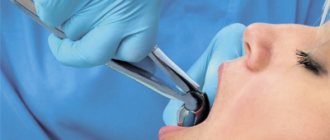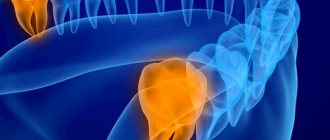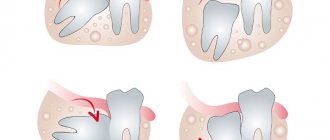The dental nerve is a component of the pulp. It is thanks to the accumulation of nerve processes in the pulp that the tooth reacts to changes in temperature, sweet and sour. Together with nerve endings, this tissue contains blood vessels that supply the tooth with vital microelements.
The pulp is located under the crown and at the root of the tooth. It is a reliable guard against infection and bacteria in the deeper layers of the tooth.
Important: removing a nerve threatens the tooth with impaired blood supply, loss of sensitivity and demineralization. However, despite such consequences, there are often cases when only nerve removal helps to save a tooth.
Causes of pain
Pain after wisdom tooth removal is the body’s protective reaction to external intervention. This is absolutely normal, since an open, fresh wound remains in place of the figure eight. Gradually, a blood clot forms in the socket, acting as a “protective cushion” that prevents pathogenic microflora from entering and multiplying. That is, the pain syndrome appears due to damage that occurred during the operation:
- injuries to bone tissue or gums;
- damage to nerve fibers or blood vessels;
- inflammation of the gums.
In addition to pain after removing the figure eight, there are a number of other symptoms that should be taken into account:
- in the first few hours it hurts to open your mouth;
- soft tissue swelling;
- pain radiating to the temple;
- increase in temperature (37-37.5°C);
- feeling of ear fullness;
- bad breath;
- swelling of the cheeks or lips.
The listed symptoms are considered normal if they begin to subside after 1-2 days.
Diagnostics
The neurologist makes a diagnosis based on the clinical picture, the patient's medical history, the results of a neurological examination and a physical examination. The doctor must rule out diseases that may manifest as facial pain (herpes, headaches). An accurate diagnosis is necessary in order to choose the right tactics for treating neuritis. With neuritis, palpation of the exit points of the trigeminal nerve is accompanied by painful sensations. Diagnosis includes MRI. This is necessary in order to exclude tumors and demyolinating diseases. The diagnosis can be confirmed by the positive effect of low-dose anticonvulsants or tricyclic antidepressants.
Possible complications
There are several reasons why complications arise after the removal of the eighth molar: improper oral care, inexperience or negligence of the surgeon, complex removal with severe trauma to the gums. The most common complications include:
- Paresthesia.
If the nerve endings are damaged, the cheeks, lips, tongue and chin become numb. Possible diction problems. Symptoms may last up to two weeks.
- Alveolitis.
The most common complication after removal of the eighth molar. Development is provoked by an incompletely removed tooth or an open socket, without a blood clot. The “true friend” of such a complication is bad breath, which does not go away for a long time.
- Hematomas.
The reasons for the appearance are damaged blood vessels during removal.
- Flux.
If hygiene is not observed, bacteria enter the wound, which provokes inflammation of the periosteum. Symptoms: pain, fever, redness and swelling of the gums.
If severe pain after the removal of a wisdom tooth does not subside, but rather intensifies, symptoms such as swelling, bruising and edema progress - this is already a pathological process that requires the intervention of a specialist.
Reasons and indications for removal
Dentists determine a list of indications for tooth nerve removal:
- caries in an advanced form (after the destruction of enamel and dentin, bacteria reach the pulp and gradually destroy it. If you go to the clinic in a timely manner, the doctor will not remove the nerve. The only thing the patient has to go through is cleaning the tissues affected by the pathology and filling the canal);
- tooth trauma (despite the most common trauma to the front teeth, premolars and molars often suffer from falls or impacts);
- infection entering the pulp by destroying the apex of the root unit.
Upcoming prosthetics is also a reason to remove the nerve. If more than 75% of the tooth is destroyed, the pulp is completely removed. This precaution indicates the high professionalism of the dentist, since the unremoved pulp under the metal-ceramic crown will overheat and cause quite painful sensations. Removing the nerve (tooth depulpation) under the crown is a more expensive and problematic procedure. It would be more reasonable to prevent this complication from occurring.
Often patients do not want to re-visit a dentist who made a mistake during prosthetics. Our specialists often encounter a problem that arose due to the fault of colleagues from other clinics.
Simple and complex removal
How complex the operation will be directly depends on the location of the eighth molar, the correctness of its growth, the complexity of the root system and the integrity of the tooth being removed. For example, if there is severe caries damage, the doctor will have to cut it into several pieces and only then remove it.
Easy removal
Simple extraction is the extraction of a tooth using forceps, without the help of any other dental instruments. During a simple extraction, the molar is easily removed from the gums, usually without complications. Most often, figure eights of the upper jaw are removed this way, because they are clearly visible and their roots are located exactly in the gum. In rare cases, there is a problem with the removal of upper molars. Accordingly, tissue regeneration also occurs quickly. On the 3-4th day, instead of a blood clot, young connective tissue forms, after 2-3 weeks filling the entire depth of the hole. On average, bone tissue is formed after 3 months.
Complex removal – what to expect?
Complex removal is one that requires drilling out the jawbone or cutting through soft tissue. This is mainly required when extracting figure eights from the lower jaw, since the root system here is more complex. Often there is abnormal growth (impacted or dystopic tooth), in which case only complex extraction is indicated. In the area of the lower jaw, the vessels pass close to the root system and there are more nerve endings, so it is always more difficult to remove lower molars. If the doctor considers it necessary, stitches are applied after the operation.
How long pain and healing last after wisdom tooth removal depends on the following factors: the presence of an inflammatory process during the procedure, the complexity of the operation, the degree of trauma after removal, the characteristics of the body, proper hygienic care, and taking medications after surgery. A timely operation is accompanied by rapid tissue regeneration, without the need for antibiotic therapy.
Attention! A wisdom tooth hood is a soft tissue that covers an impacted tooth. This is an “extra” formation in the oral cavity, and it is very important to remove it before inflammation begins. The hood is an additional source of inflammation. If it is not excised in time, an inflammatory process may begin and antibiotics may be required.
How is a wisdom tooth removed?
Extraction of the third molar is performed for the following reasons::
- incorrect location causing discomfort to the patient;
- carious lesions that cannot be treated due to difficulty in accessing the dental unit;
- severe destruction;
- before starting orthodontic treatment.
After examination and diagnosis, the specialist decides whether to preserve or remove the tooth. There are two types of figure eight extraction: simple and complex.
Easy removal:
- anesthesia;
- tooth extraction using forceps or an elevator;
- removing debris and splinters from the hole;
- treatment of the hole with antiseptic agents;
- applying a bandage to stop bleeding.
Extraction of a wisdom tooth located under the gum and in a horizontal position is considered difficult This procedure includes the following steps:
- anesthesia;
- cutting the gums with a scalpel;
- sawing the tooth (the root is separated from the crown using a bur);
- extraction of crown and roots;
- antiseptic treatment;
- applying a bandage;
- suturing.
Flux after removal
Flux is characterized by purulent accumulations inside soft tissues. The formation of flux can be caused by harmful microorganisms located in the wound or in the oral cavity itself.
With gumboil, there is aching pain in the gums, a thickening appears on the side of the cheek, the lymph nodes become enlarged, and general health worsens.
If after tooth extraction the pain in the gums does not subside for a long time, you should consult your doctor. To eliminate inflammation, a specialist may prescribe antiseptic, anti-inflammatory and painkillers.
COMPLICATIONS AFTER TOOTH EXTRACTION: HOW AND WHY?
After tooth extraction, your gums become inflamed, your jaw hurts, swelling appears, your cheek is swollen, your temperature rises? These are all the complications that arise after tooth extraction. Some of them go away on their own, but others require immediate medical intervention. Why do they appear, how to deal with them and when should you really worry? Tooth extraction is a difficult operation that traumatizes the tissue surrounding the tooth. Therefore, it is not surprising that unpleasant consequences occur after tooth extraction: the most common of them is swelling. Patients often complain that after tooth extraction, the gums become swollen, swelling of the cheek or a slight gumboil appears. This is caused by partial destruction of the soft tissue around the tooth. This is unpleasant, but if the tumor is small, it goes away on its own in 2-3 days. To relieve swelling after tooth extraction, ice can be applied to the cheek for about 10 minutes. If the swelling has not gone away after a day, apply heat. Keep the heating pad for 20 minutes, then take a break for 10 minutes and put the heating pad back on. Sometimes swelling can be caused by an allergy to the anesthesia. In this case, histamine, an antiallergic drug, will help. But if the swelling increases, then it may be a sign of inflammation that has arisen after tooth extraction. In this case, you should immediately consult a doctor. Temperature after tooth extraction. An increase in temperature is a normal reaction of the body to traumatic tooth extraction. It can last for 2 - 3 days, increasing in the evening. Maintain prescribed hygiene and take antipyretic medications. But if the condition does not improve, then you should visit the dentist. Pain after tooth extraction. Another common complaint is that after tooth extraction, the gums, adjacent tooth, jaw, and throat hurt. As a rule, these are common symptoms after a traumatic procedure. They are caused by damage to the periodontal tissues and nerves, which goes away on its own after a few days. For example, if a temporary aching pain appears after tooth extraction, this is normal. To relieve discomfort, you can take painkillers. But if the pain intensifies, it is still worth visiting a doctor. Uncomfortable sensations and swelling are possible after complex tooth extraction. But pain and fever are abnormal symptoms that should be reported to your doctor immediately. Often, pain and fever occur due to the fact that the patient “rinses out” a special clot that the doctor forms in the socket of the extracted tooth. The clot protects the hole and subsequently helps it heal as quickly as possible (on average, it heals completely within 6 weeks, sometimes faster, depending on the specific situation). If a clot is lost, inflammation may occur, which causes acute pain combined with fever. That is why, after tooth extraction, the doctor should always give the correct recommendations for caring for the cavity, and the patient should strictly follow them. Bleeding after tooth extraction. Immediately after a tooth is removed, there is bleeding from the socket. This is quite normal, since blood vessels rupture during surgery. In this case, the doctor will provide you with the necessary assistance. But sometimes bleeding occurs a few hours after surgery. To stop the bleeding yourself after tooth extraction, apply a small gauze swab to the hole and lightly bite it. After 15 minutes the blood stops flowing. But if the bleeding does not stop for a long time, you should consult a doctor. Pus after tooth extraction. Suppuration of the socket and periodontal tissues is caused by their infection. It can happen for several reasons. Firstly, if you did not follow the dentist's instructions regarding individual oral hygiene after surgery. Secondly, the cause may be a tooth fragment remaining in the tissues after removal. Thirdly, there is a high risk of suppuration after a complex wisdom tooth extraction, for example. If the inflammation is not treated in time, then some time after removal, suppuration, a fistula on the gum, and even a cyst may appear. If pus appears at the surgical site, consult a doctor. He will find and eliminate the cause of the inflammatory process. Dry socket after tooth extraction. A blood clot should remain in the socket after surgery. This is a very important part of the healing process. This clot protects the bone and nerve endings and serves to form bone tissue after tooth extraction. Therefore, you should not rinse your mouth for a day after the procedure and eat hot food - this will help the clot dissolve. But sometimes it does not form, and a dry socket appears. Dry socket is considered a complication. It most often occurs after complex removals accompanied by significant trauma. If there is no blood clot, then the hole after tooth extraction hurts, and sometimes it seems that the ear also hurts. Often there is an unpleasant taste in the mouth. The consequence of a dry socket after a traumatic tooth extraction can be inflammation of the gums or alveolitis. Therefore, if you experience acute pain in the socket, consult a doctor immediately. He will place a tampon with a special anti-inflammatory gel on the hole. Tampons are changed until healing begins. Paresthesia after tooth extraction. This is the name for numbness in the tongue, lips or chin after tooth extraction as a result of nerve damage. Most often it occurs after the removal of wisdom teeth, which are located next to the facial nerves. This unpleasant complication goes away within 1–2 weeks after surgery. But if the damage is severe, paresthesia may become permanent. Fortunately, this complication is quite rare. Alveolitis after tooth extraction. This is a serious complication caused by tooth extraction, which has several causes. This may be the presence of chronic inflammation of the tissues around the tooth - periodontitis, or a dry socket. In addition, alveolitis occurs if, after tooth extraction, a dental fragment remains in the tissues. All these factors cause infection of the hole and the development of its inflammation. 1–3 days after tooth extraction, pain occurs, followed by a specific smell from the mouth. Then these symptoms intensify, the hole becomes covered with a gray coating, and it becomes impossible to eat due to severe pain. In this case, only a doctor will help you, who will carry out the necessary treatment and clean the hole from infection. Do not self-medicate under any circumstances - alveolitis can develop into periostitis (inflammation of the periosteum), causing an abscess and phlegmon. Painful sensations after the removal procedure are unpleasant, but inevitable. Remember, if these sensations intensify, then in this case, complications after tooth extraction should be treated by a specialist. Do not delay your visit to the dentist, dulling the pain with analgesics. Correct and timely treatment will help you avoid more serious complications.
Main reasons
So why does a tooth hurt after nerve removal? In most cases, this is caused by poor quality work by the dentist. High-quality treatment of canals requires precision, accuracy and excellent mastery of technology, and inattention and careless attitude lead to errors in treatment, which in turn lead to very painful complications.
Here are the possible causes of pain after nerve removal.
The canals are not completely closed with filling material
If the doctor made a mistake when assessing the depth of the canals and did not seal them completely, then over time bacteria can accumulate in the voids and provoke an inflammatory process. This error does not manifest itself immediately: for quite a long time the patient may think that everything is fine. However, sooner or later destructive processes will still manifest themselves - as a rule, sharp pain that appears on its own or when pressing on the tooth. Inflammation in an unclosed canal can lead to destruction of the tooth root, the formation of a granuloma or cyst.
The filling material has gone beyond the root
One of the most common complications is in which, after removal of the nerve, the tooth hurts when pressing and biting food. The situation is exactly the opposite of the previous one: in this case, the cause of pain in the tooth after removal of the nerve is not the lack of filling paste in the canal, but its excess. The paste enters the jawbone, causing irritation, inflammation and the body's immune response to the foreign body. Pain appears immediately after obturation (filling) of the canals, and its intensity directly depends on the amount of paste that has gone beyond the tooth root: the larger the volume of the foreign body in the jaw bone, the stronger the discomfort.
The end of the dental instrument broke off and remained in the canal
This also happens. To extract the pulp and process the canals, very thin instruments are used, which require high precision from the doctor. If manipulations are performed with excessive pressure on the instrument, without the use of a special lubricating gel, or simply carelessly, then the thin end of the endodontic instrument may break off and remain in the root canal. Then access to the canal will be blocked, and its high-quality processing and filling will become impossible. Over time, this will certainly lead to inflammation, pain and destruction of the tooth root.
Perforation of the tooth root occurred during canal treatment
Perforation is a puncture of the root wall during canal processing with an endodontic instrument. It is dangerous in itself: it can lead to inflammation and suppuration of the tissue in the puncture area, but also through the hole, filling material can get into the jawbone with all the ensuing consequences. Due to anesthesia, the patient will not feel the moment of the puncture, but after the effect of the painkillers wears off, he will definitely feel a sharp pain. It is practically not relieved by analgesics.
The carious cavities were not drilled out completely
Another “delayed” complication after nerve removal is when the doctor inadvertently leaves caries-affected tissue in the tooth. A filled tooth may not remind you of itself for several weeks or even months, but sooner or later the unpleasant sensations will definitely return. Pathogenic bacteria will continue the process of tooth destruction, affecting healthy tissue, causing inflammation and pain.
The patient had an allergic reaction to the components of the filling paste
This is the only cause of post-filling complications that does not depend on the actions of the doctor. Individual intolerance to the filling material leads to swelling of the gums, burning, and nagging pain in the area of intervention. After removal of the nerve, the tooth aches, the eyes may become watery, the lips and cheeks may swell, there may be nasal congestion and even a rise in temperature.











